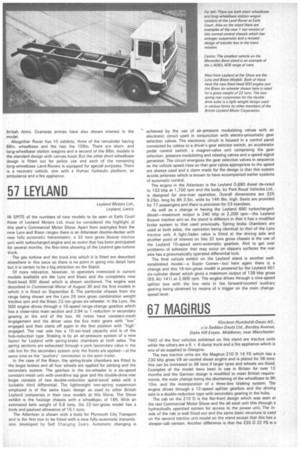57 LEYLAND
Page 133

If you've noticed an error in this article please click here to report it so we can fix it.
Leyland Motors Ltd., Leyland, Lancs.
IN SPITE of the numbers of new models to be seen at Earls Court those of Leyland Motors Ltd. must be considered the highlight of this year's Commercial Motor Show. Apart from examples from the new Lynx and Bison ranges there is an Atlantean double-decker with new fully automatic transmission, a 32 tons gross Beaver tractive unit with turbocharged engine and an event that has been anticipated for several months, the first-time showing of the Leyland gas-turbine truck.
The gas turbine and the truck into which it is fitted are described elsewhere in this issue so there is no point in going into detail here but it is certain to be a big attraction on the Stand.
Of more relevance, however, to operators interested in current models available are the Lynx and Bison and the completely new fixed-head 500 diesel which is shown sectioned. The engine was described in Commercial Motor of August 30 and the first models in which it is fitted on September 6. The particular chassis from the range being shown are the Lynx 28 tons gross combination weight tractive unit and the Bison 22-ton-gross six-wheeler. In the Lynx, the 500 engine drives through a 10-speed range-change gearbox which has a close-ratio main section and 3.94 to 1 reduction in secondary gearing at the end of the box. All ratios have constant-mesh engagement and the driver uses the five main gears with "low" engaged and then starts off again in the first position with "high" engaged. The rear axle has a 10-ton-load capacity and is of the hub-reduction type. Braking is by an air-pressure system of a new layout for Leyland with spring brake chambers at both axles. The spring sections are exhausted through a park /secondary valve in the cab but for the secondary system only the fronts are applied—at the same time as the "auxiliary" connection to the semi-trailer.
In the case of the Bison, the spring-brake chambers are fitted to the bogie brakes and all four wheels are applied for parking and the secondary system. The gearbox in the six-wheeler is a six-speed constant-mesh unit with overdrive top gear and the double-drive rear bogie consists of two double-reduction spiral-bevel axles with a lockable third differential. The lightweight two-spring suspension employed is of the same basic design as used by other British Leyland companies in their new models at this Show. The Show exhibit is the haulage chassis with a wheelbas•J of 161t. With an estimated kerb weight of 5.9 tons, the 22-ton-gross model has a body and payload allowance of 16.1 tons.
The Atlantean is shown with a body for Plymouth City Transport and is the first bus to be fitted with a new fully-automatic transmission developed by Self Changing Gears. Automatic changing is achieved by the use of air-pressure modulating valves with an electronic circuit used in conjunction with electro-pneumatic gear selection valves. The electronic circuit is housed in a control panel connected by cables to a driver's gear selector switch, an accelerator pedal control switch, a magnet-valve unit comprising the gear selection, pressure modulating and relaxing valves and a speed-signal generator. The circuit energizes the gear selection valves in sequence as the vehicle speed rises so that gear ratios appropriate to the speed are always used and a claim made for the design is that this system avoids jerkiness which is known to have accompanied earlier systems of automatic control.
The engine in the Atlantean is the Leyland 0.680 diesel de-rated to 153 bhp at 1,750 rpm and the body, by Park Royal Vehicles Ltd., is designed for one-man operation. Overall dimensions are 32ft 9.25in. long by 8ft 2.5in. wide by 14ft 61n. high. Seats are provided for 77 passengers and there is provision for 23 standees.
As well as a change in having the Leyland 690 turbochargeddiesel—maximum output is 240 bhp at 2,200 rpm--the Leyland Beaver tractive unit on the stand is different in that it has a modified brake system to that used previously. Spring brake chambers are used at both axles, the operation being identical to that of the Lynx tractive unit. A light/laden valve is fitted at the driving axle and another point of interest on this 32 tons gross chassis is the use of the Leyland 10-speed semi-automatic gearbox. And to get over problems of adhesion that may occur on slippery surfaces the rear axle has a pneumatically operated differential lock.
The final vehicle exhibit on the Leyland stand is another wellestablished model—a Super Comet—but here again there is a change and this 16-ton-gross model is powered by the Leyland 401 six-cylinder diesel which gives a maximum output of 138 bhp gross {BS AU 141) at 2,600 rpm. The engine drives through a nine-speed splitter box with the low ratio in the forward-located auxiliary gearing being obtained by means of a trigger on the main changespeed lever.


















































































































































































































































































































































































